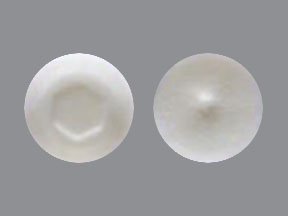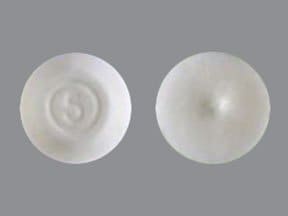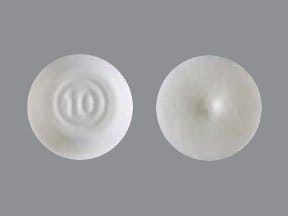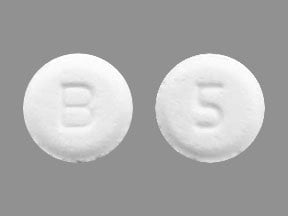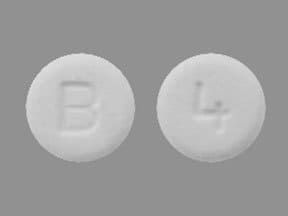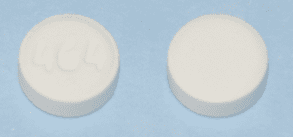Boxed Warning
Increased mortality in elderly patients with dementia-related psychosis:
Elderly patients with dementia-related psychosis treated with antipsychotic drugs are at an increased risk of death. Asenapine is not approved for the treatment of patients with dementia-related psychosis.
Dosage Forms
Excipient information presented when available (limited, particularly for generics); consult specific product labeling.
Patch 24 Hour, Transdermal:
Secuado: 3.8 mg/24 hr (1 ea, 30 ea); 5.7 mg/24 hr (1 ea, 30 ea); 7.6 mg/24 hr (1 ea, 30 ea)
Tablet Sublingual, Sublingual:
Saphris: 2.5 mg, 5 mg, 10 mg [black cherry flavor]
Pharmacology
Mechanism of Action
Asenapine is a dibenzo-oxepino pyrrole atypical antipsychotic with mixed serotonin-dopamine antagonist activity. It exhibits high affinity for 5-HT1A, 5-HT1B, 5-HT2A, 5-HT2B, 5-HT2C, 5-HT5-7, D1-4, H1 and, alpha1- and alpha2-adrenergic receptors; moderate affinity for H2 receptors. Asenapine has no significant affinity for muscarinic receptors. The binding affinity to the D2 receptor is 19 times lower than the 5-HT2A affinity (Weber 2009). The addition of serotonin antagonism to dopamine antagonism (classic neuroleptic mechanism) is thought to improve negative symptoms of psychoses and reduce the incidence of extrapyramidal side effects as compared to typical antipsychotics (Huttunen 1995).
Pharmacokinetics/Pharmacodynamics
Absorption
Sublingual: Rapid; Transdermal: External heat source (eg, heating pad) applied to patch increases rate and extent of absorption.
Distribution
Vd: ~20 to 25 L/kg.
Metabolism
Hepatic via CYP1A2 oxidation and UGT1A4 glucuronidation.
Excretion
Urine (~50%); feces (~40%).
Time to Peak
Sublingual: 0.5 to 1.5 hours; Transdermal: 12 to 24 hours.
Half-Life Elimination
Sublingual: Terminal: ~24 hours; Transdermal: ~30 hours.
Protein Binding
95% (including albumin and α1-acid glycoprotein).
Use in Specific Populations
Special Populations: Hepatic Function Impairment
Severe hepatic impairment (Child-Pugh class C) exposure was 7 times higher than in healthy patients.
Special Populations: Elderly
Clearance is decreased, increasing exposure by 30% to 40%.
Use: Labeled Indications
Bipolar disorder (sublingual tablet only): Treatment of acute manic or mixed episodes associated with bipolar I disorder (as monotherapy in adult and pediatric patients ≥10 years of age or adjunctive treatment with lithium or valproate in adults) and maintenance treatment in adults (as monotherapy).
Schizophrenia (transdermal patch, sublingual tablet): Treatment of adults with schizophrenia.
Use: Off Label
Agitation/aggression (severe, acute) associated with psychiatric disorders (eg, bipolar disorder, schizophrenia), substance intoxication, or other organic causesbyes
Data from a randomized, double-blind, placebo-controlled trial suggest the use of sublingual asenapine may be beneficial in the treatment of agitation associated with psychiatric disorders, including schizophrenia and bipolar disorder, and substance intoxications Pratts 2014.
Based on the World Federation of Societies of Biological Psychiatry expert consensus for the assessment and management of agitation in psychiatry, oral medications, including dissolvable formulations such as sublingual asenapine, are recommended and preferred in the management of mild psychomotor agitation associated with psychiatric conditions (eg, schizophrenia, bipolar disorder), substance intoxication, or other organic causes. Based on the Canadian Network for Mood and Anxiety Treatments and International Society for Bipolar Disorders guidelines for the management of patients with bipolar disorder, sublingual asenapine is recommended for the management of severe acute agitation in patients with bipolar disorder when preferred IM or inhaled options are not available or effective or when symptoms are mild and the patient is willing to take oral medication CANMAT/ISBD [Yatham 2018], WFSBP [Garriga 2016].
Psychosis/agitation associated with dementiayes
Based on the American Psychiatric Association practice guideline on the use of antipsychotics to treat agitation or psychosis in patients with dementia, antipsychotics, such as asenapine, may be considered for the treatment of agitation and psychosis in certain patients with dementia; however, evidence for efficacy is modest and use should be limited to patients whose symptoms are dangerous, severe, or cause significant patient distress due to safety risks associated with antipsychotic use.
Contraindications
Severe hepatic impairment (Child-Pugh class C); hypersensitivity to asenapine or any component of the formulation (eg, anaphylaxis, angioedema, hypotension, tachycardia, swollen tongue, dyspnea, wheezing, rash)
Dosage and Administration
Dosing: Adult
Agitation/aggression (severe, acute) associated with psychiatric disorders (eg, bipolar disorder, schizophrenia), substance intoxication, or other organic causes (alternative agent) (off-label use):
Note: Antipsychotics are appropriate when psychosis is suspected to be the primary cause of agitation/aggression. Other agents are used preferentially in some intoxications (eg, stimulants) or alcohol withdrawal. Depending on presentation, may combine with a benzodiazepine (CANMAT/ISBD [Yatham 2018]; Moore 2019; WFSBP [Hasan 2012]; Wilson 2012).
Sublingual: 10 mg as a single dose (Pratts 2014).
Bipolar disorder: Sublingual:
Acute manic or mixed episode:
Monotherapy: Initial: 5 to 10 mg twice daily; maximum dose: 10 mg twice daily.
Combination therapy (with lithium or valproate): Initial: 5 mg twice daily; may increase to 10 mg twice daily based on tolerability; maximum dose: 10 mg twice daily.
Maintenance: Monotherapy: Continue with acute episode dose; decrease to 5 mg twice daily based on response and tolerability; maximum dose: 10 mg twice daily.
Psychosis/agitation associated with dementia (off-label use): Sublingual: Initial: One-third to one-half the usual dose to treat psychosis in younger adults or the smallest available dosage. In patients without a clinically significant response after an adequate trial (eg, up to 4 weeks), taper and withdraw therapy. Only continue in patients with demonstrated benefit; attempt to taper and withdraw at regular intervals (eg, within 4 months of initiation) (APA [Reus 2016]).
Schizophrenia:
Patch: Initial: Apply 3.8 mg/24 hours patch once daily; based on efficacy and tolerability, may increase to 5.7 mg/24 hours or 7.6 mg/24 hours after 1 week.
Sublingual: Initial: 5 mg twice daily; may increase to 10 mg twice daily after 1 week based on tolerability; maximum dose: 10 mg twice daily.
Discontinuation of therapy: Gradual dose reduction is advised to avoid withdrawal symptoms (eg, insomnia, headache, GI symptoms) unless discontinuation is due to significant adverse effects. In general, when discontinuing antipsychotic therapy for a chronic psychiatric disorder (eg, bipolar disorder, schizophrenia), decreasing the dose very gradually over weeks to months (eg, reducing the dose by 10% per month) with close monitoring is suggested to allow for detection of prodromal symptoms of disease recurrence (APA [Lehman 2004]; CPA 2005).
Switching antipsychotics: An optimal universal strategy for switching antipsychotic drugs has not been established. Strategies include: cross-titration (gradually discontinuing the first antipsychotic while gradually increasing the new antipsychotic) and abrupt change (abruptly discontinuing the first antipsychotic and either increasing the new antipsychotic gradually or starting it at a treatment dose). In patients with schizophrenia at high risk of relapse, the current medication may be maintained at full dose as the new medication is increased (eg, overlap); once the new medication is at therapeutic dose, the first medication is gradually decreased and discontinued over 1 to 2 weeks (Cerovecki 2013; Remington 2005; Takeuchi 2017). Based upon clinical experience, some experts generally prefer cross-titration and overlap approaches rather than abrupt change (Post 2019; Stroup 2019).
Dosing: Geriatric
Refer to adult dosing.
Dosing: Pediatric
Bipolar disorder: Acute manic or mixed episode; monotherapy: Children ≥10 years and Adolescents ≤17 years: Sublingual: Initial: 2.5 mg twice daily; may titrate after 3 days to 5 mg twice daily, then after an additional 3 days to 10 mg twice daily based on tolerability; recommended daily dose range: 5 to 20 mg/day in two divided doses; maximum dose: 10 mg twice daily (20 mg/day).
Administration
Sublingual: Sublingual tablets should be placed under the tongue and allowed to completely dissolve. Do not split, crush, chew, or swallow. Avoid eating or drinking for at least 10 minutes after administration.
Transdermal: Do not open pouch until ready to apply a patch. Apply 1 patch daily to clean, dry, intact skin of the upper arm, upper back, abdomen, or hip and leave on for only 24 hours. Wear only 1 patch at a time and do not use the same application site 2 times in a row. Do not cut patches. If application-site reaction (irritation, burning) occurs, remove patch and apply a new patch at a new application site. May shower while wearing patch but avoid swimming, bathing. Avoid placing external heat sources (eg, heating pad, hair dryer, electric blanket, heated water bed) on the patch. Discard by folding the used patch so that the adhesive side sticks to itself. See manufacturer’s labeling for further administration instructions.
Storage
Store at 20°C to 25°C (68°F to 77°F); excursions permitted to 15°C to 30°C (59°F to 86°F).
Asenapine Images
Drug Interactions
Acetylcholinesterase Inhibitors (Central): May enhance the neurotoxic (central) effect of Antipsychotic Agents. Severe extrapyramidal symptoms have occurred in some patients. Monitor therapy
Alcohol (Ethyl): CNS Depressants may enhance the CNS depressant effect of Alcohol (Ethyl). Monitor therapy
Alizapride: May enhance the CNS depressant effect of CNS Depressants. Monitor therapy
Amifampridine: Agents With Seizure Threshold Lowering Potential may enhance the neuroexcitatory and/or seizure-potentiating effect of Amifampridine. Monitor therapy
Amisulpride: Antipsychotic Agents may enhance the adverse/toxic effect of Amisulpride. Management: Drugs listed as exceptions to this monograph are discussed in further detail in separate drug interaction monographs. Avoid combination
Amphetamines: Antipsychotic Agents may diminish the stimulatory effect of Amphetamines. Monitor therapy
Antidiabetic Agents: Hyperglycemia-Associated Agents may diminish the therapeutic effect of Antidiabetic Agents. Monitor therapy
Anti-Parkinson Agents (Dopamine Agonist): Antipsychotic Agents (Second Generation [Atypical]) may diminish the therapeutic effect of Anti-Parkinson Agents (Dopamine Agonist). Management: Consider using an alternative antipsychotic agent when possible in patients with Parkinson disease. If an atypical antipsychotic is necessary, consider using clozapine or quetiapine, which may convey the lowest interaction risk. Consider therapy modification
ARIPiprazole: CYP2D6 Inhibitors (Weak) may increase the serum concentration of ARIPiprazole. Management: Monitor for increased aripiprazole pharmacologic effects. Aripiprazole dose adjustments may or may not be required based on concomitant therapy and/or indication. Consult full interaction monograph for specific recommendations. Monitor therapy
Azelastine (Nasal): CNS Depressants may enhance the CNS depressant effect of Azelastine (Nasal). Avoid combination
Blonanserin: CNS Depressants may enhance the CNS depressant effect of Blonanserin. Consider therapy modification
Blood Pressure Lowering Agents: May enhance the hypotensive effect of Antipsychotic Agents (Second Generation [Atypical]). Monitor therapy
Brexanolone: CNS Depressants may enhance the CNS depressant effect of Brexanolone. Monitor therapy
Brimonidine (Topical): May enhance the CNS depressant effect of CNS Depressants. Monitor therapy
Bromopride: May enhance the adverse/toxic effect of Antipsychotic Agents. Avoid combination
Bromperidol: May enhance the CNS depressant effect of CNS Depressants. Avoid combination
Buprenorphine: CNS Depressants may enhance the CNS depressant effect of Buprenorphine. Management: Consider reduced doses of other CNS depressants, and avoiding such drugs in patients at high risk of buprenorphine overuse/self-injection. Initiate buprenorphine at lower doses in patients already receiving CNS depressants. Consider therapy modification
BuPROPion: May enhance the neuroexcitatory and/or seizure-potentiating effect of Agents With Seizure Threshold Lowering Potential. Monitor therapy
Cannabidiol: May enhance the CNS depressant effect of CNS Depressants. Monitor therapy
Cannabis: May enhance the CNS depressant effect of CNS Depressants. Monitor therapy
Chlormethiazole: May enhance the CNS depressant effect of CNS Depressants. Management: Monitor closely for evidence of excessive CNS depression. The chlormethiazole labeling states that an appropriately reduced dose should be used if such a combination must be used. Consider therapy modification
Chlorphenesin Carbamate: May enhance the adverse/toxic effect of CNS Depressants. Monitor therapy
Ciprofloxacin (Systemic): May increase the serum concentration of Asenapine. Monitor therapy
CNS Depressants: May enhance the adverse/toxic effect of other CNS Depressants. Monitor therapy
CYP1A2 Inhibitors (Strong): May increase the serum concentration of Asenapine. Monitor therapy
Deutetrabenazine: May enhance the adverse/toxic effect of Antipsychotic Agents. Specifically, the risk for akathisia, parkinsonism, or neuroleptic malignant syndrome may be increased. Monitor therapy
Dimethindene (Topical): May enhance the CNS depressant effect of CNS Depressants. Monitor therapy
Doxylamine: May enhance the CNS depressant effect of CNS Depressants. Management: The manufacturer of Diclegis (doxylamine/pyridoxine), intended for use in pregnancy, specifically states that use with other CNS depressants is not recommended. Monitor therapy
Dronabinol: May enhance the CNS depressant effect of CNS Depressants. Monitor therapy
Droperidol: May enhance the CNS depressant effect of CNS Depressants. Management: Consider dose reductions of droperidol or of other CNS agents (eg, opioids, barbiturates) with concomitant use. Exceptions to this monograph are discussed in further detail in separate drug interaction monographs. Consider therapy modification
Esketamine: May enhance the CNS depressant effect of CNS Depressants. Monitor therapy
Flunitrazepam: CNS Depressants may enhance the CNS depressant effect of Flunitrazepam. Consider therapy modification
Guanethidine: Antipsychotic Agents may diminish the therapeutic effect of Guanethidine. Monitor therapy
Haloperidol: QT-prolonging Agents (Indeterminate Risk - Avoid) may enhance the QTc-prolonging effect of Haloperidol. Monitor therapy
HYDROcodone: CNS Depressants may enhance the CNS depressant effect of HYDROcodone. Management: Avoid concomitant use of hydrocodone and benzodiazepines or other CNS depressants when possible. These agents should only be combined if alternative treatment options are inadequate. If combined, limit the dosages and duration of each drug. Consider therapy modification
HydrOXYzine: May enhance the CNS depressant effect of CNS Depressants. Monitor therapy
Iohexol: Agents With Seizure Threshold Lowering Potential may enhance the adverse/toxic effect of Iohexol. Specifically, the risk for seizures may be increased. Management: Discontinue agents that may lower the seizure threshold 48 hours prior to intrathecal use of iohexol. Wait at least 24 hours after the procedure to resume such agents. In nonelective procedures, consider use of prophylactic anticonvulsants. Consider therapy modification
Iomeprol: Agents With Seizure Threshold Lowering Potential may enhance the adverse/toxic effect of Iomeprol. Specifically, the risk for seizures may be increased. Management: Discontinue agents that may lower the seizure threshold 48 hours prior to intrathecal use of iomeprol. Wait at least 24 hours after the procedure to resume such agents. In nonelective procedures, consider use of prophylactic anticonvulsants. Consider therapy modification
Iopamidol: Agents With Seizure Threshold Lowering Potential may enhance the adverse/toxic effect of Iopamidol. Specifically, the risk for seizures may be increased. Management: Discontinue agents that may lower the seizure threshold 48 hours prior to intrathecal use of iopamidol. Wait at least 24 hours after the procedure to resume such agents. In nonelective procedures, consider use of prophylactic anticonvulsants. Consider therapy modification
Kava Kava: May enhance the adverse/toxic effect of CNS Depressants. Monitor therapy
Lemborexant: May enhance the CNS depressant effect of CNS Depressants. Management: Dosage adjustments of lemborexant and of concomitant CNS depressants may be necessary when administered together because of potentially additive CNS depressant effects. Close monitoring for CNS depressant effects is necessary. Consider therapy modification
Lithium: May enhance the neurotoxic effect of Antipsychotic Agents. Lithium may decrease the serum concentration of Antipsychotic Agents. Specifically noted with chlorpromazine. Monitor therapy
Lofexidine: May enhance the CNS depressant effect of CNS Depressants. Management: Drugs listed as exceptions to this monograph are discussed in further detail in separate drug interaction monographs. Monitor therapy
Magnesium Sulfate: May enhance the CNS depressant effect of CNS Depressants. Monitor therapy
Mequitazine: Antipsychotic Agents may enhance the arrhythmogenic effect of Mequitazine. Management: Consider alternatives to one of these agents when possible. While this combination is not specifically contraindicated, mequitazine labeling describes this combination as discouraged. Consider therapy modification
Methotrimeprazine: CNS Depressants may enhance the CNS depressant effect of Methotrimeprazine. Methotrimeprazine may enhance the CNS depressant effect of CNS Depressants. Management: Reduce adult dose of CNS depressant agents by 50% with initiation of concomitant methotrimeprazine therapy. Further CNS depressant dosage adjustments should be initiated only after clinically effective methotrimeprazine dose is established. Consider therapy modification
Methylphenidate: Antipsychotic Agents may enhance the adverse/toxic effect of Methylphenidate. Methylphenidate may enhance the adverse/toxic effect of Antipsychotic Agents. Monitor therapy
Metoclopramide: May enhance the adverse/toxic effect of Antipsychotic Agents. Avoid combination
MetyroSINE: CNS Depressants may enhance the sedative effect of MetyroSINE. Monitor therapy
MetyroSINE: May enhance the adverse/toxic effect of Antipsychotic Agents. Monitor therapy
Minocycline (Systemic): May enhance the CNS depressant effect of CNS Depressants. Monitor therapy
Nabilone: May enhance the CNS depressant effect of CNS Depressants. Monitor therapy
Opioid Agonists: CNS Depressants may enhance the CNS depressant effect of Opioid Agonists. Management: Avoid concomitant use of opioid agonists and benzodiazepines or other CNS depressants when possible. These agents should only be combined if alternative treatment options are inadequate. If combined, limit the dosages and duration of each drug. Consider therapy modification
Orphenadrine: CNS Depressants may enhance the CNS depressant effect of Orphenadrine. Avoid combination
Oxomemazine: May enhance the CNS depressant effect of CNS Depressants. Avoid combination
OxyCODONE: CNS Depressants may enhance the CNS depressant effect of OxyCODONE. Management: Avoid concomitant use of oxycodone and benzodiazepines or other CNS depressants when possible. These agents should only be combined if alternative treatment options are inadequate. If combined, limit the dosages and duration of each drug. Consider therapy modification
Paraldehyde: CNS Depressants may enhance the CNS depressant effect of Paraldehyde. Avoid combination
PARoxetine: Asenapine may increase the serum concentration of PARoxetine. Management: Decrease the paroxetine dose by half when used concomitantly with asenapine. Monitor patients receiving this combination closely for signs and symptoms of increased paroxetine toxicity. Consider therapy modification
Perampanel: May enhance the CNS depressant effect of CNS Depressants. Management: Patients taking perampanel with any other drug that has CNS depressant activities should avoid complex and high-risk activities, particularly those such as driving that require alertness and coordination, until they have experience using the combination. Consider therapy modification
Perhexiline: CYP2D6 Inhibitors (Weak) may increase the serum concentration of Perhexiline. Monitor therapy
Piribedil: Antipsychotic Agents may diminish the therapeutic effect of Piribedil. Piribedil may diminish the therapeutic effect of Antipsychotic Agents. Management: Use of piribedil with antiemetic neuroleptics is contraindicated, and use with antipsychotic neuroleptics, except for clozapine, is not recommended. Avoid combination
QT-prolonging Agents (Highest Risk): QT-prolonging Agents (Indeterminate Risk - Avoid) may enhance the QTc-prolonging effect of QT-prolonging Agents (Highest Risk). Management: Monitor for QTc interval prolongation and ventricular arrhythmias when these agents are combined. Patients with additional risk factors for QTc prolongation may be at even higher risk. Monitor therapy
Quinagolide: Antipsychotic Agents may diminish the therapeutic effect of Quinagolide. Monitor therapy
Rufinamide: May enhance the adverse/toxic effect of CNS Depressants. Specifically, sleepiness and dizziness may be enhanced. Monitor therapy
Selective Serotonin Reuptake Inhibitors: CNS Depressants may enhance the adverse/toxic effect of Selective Serotonin Reuptake Inhibitors. Specifically, the risk of psychomotor impairment may be enhanced. Monitor therapy
Serotonergic Agents (High Risk): May enhance the adverse/toxic effect of Antipsychotic Agents. Specifically, serotonergic agents may enhance dopamine blockade, possibly increasing the risk for neuroleptic malignant syndrome. Antipsychotic Agents may enhance the serotonergic effect of Serotonergic Agents (High Risk). This could result in serotonin syndrome. Monitor therapy
Sodium Oxybate: May enhance the CNS depressant effect of CNS Depressants. Management: Consider alternatives to combined use. When combined use is needed, consider minimizing doses of one or more drugs. Use of sodium oxybate with alcohol or sedative hypnotics is contraindicated. Consider therapy modification
Sulpiride: Antipsychotic Agents may enhance the adverse/toxic effect of Sulpiride. Avoid combination
Suvorexant: CNS Depressants may enhance the CNS depressant effect of Suvorexant. Management: Dose reduction of suvorexant and/or any other CNS depressant may be necessary. Use of suvorexant with alcohol is not recommended, and the use of suvorexant with any other drug to treat insomnia is not recommended. Consider therapy modification
Tapentadol: May enhance the CNS depressant effect of CNS Depressants. Management: Avoid concomitant use of tapentadol and benzodiazepines or other CNS depressants when possible. These agents should only be combined if alternative treatment options are inadequate. If combined, limit the dosages and duration of each drug. Consider therapy modification
Tetrabenazine: May enhance the adverse/toxic effect of Antipsychotic Agents. Monitor therapy
Tetrahydrocannabinol: May enhance the CNS depressant effect of CNS Depressants. Monitor therapy
Tetrahydrocannabinol and Cannabidiol: May enhance the CNS depressant effect of CNS Depressants. Monitor therapy
Thalidomide: CNS Depressants may enhance the CNS depressant effect of Thalidomide. Avoid combination
Trimeprazine: May enhance the CNS depressant effect of CNS Depressants. Monitor therapy
Zolpidem: CNS Depressants may enhance the CNS depressant effect of Zolpidem. Management: Reduce the Intermezzo brand sublingual zolpidem adult dose to 1.75 mg for men who are also receiving other CNS depressants. No such dose change is recommended for women. Avoid use with other CNS depressants at bedtime; avoid use with alcohol. Consider therapy modification
Adverse Reactions
Actual frequency may be dependent upon dose and/or indication.
>10%:
Central nervous system: Drowsiness (children and adolescents: 46% to 53%; adults: 3% to 26%;), insomnia (adults: 15% to 16%; children and adolescents: 4%), akathisia (adults: 4% to 15%; children and adolescents: 1% to 2%), fatigue (4% to 14%), extrapyramidal reaction (adults: 8% to 13%; children and adolescents: 1% to 2%), headache (8% to 11%)
Endocrine & metabolic: Weight gain (adults: 1% to 22%; children and adolescents: 2% to 12%), increased serum triglycerides (adults: 3% to 18%; children and adolescents: 2% to 4%), increased serum glucose (adults: 3% to 16%; children and adolescents: 2%), decreased HDL cholesterol (6% to 15%), increased serum cholesterol (adults: 2% to 14%)
Gastrointestinal: Oral hypoesthesia (5% to 30%)
Local: Application site reaction (transdermal: 14% to 15%)
Neuromuscular & skeletal: Increased creatine phosphokinase in blood specimen (adults: 11%)
1% to 10%:
Cardiovascular: Hypertension (adults: 2% to 3%), tachycardia (1% to 3%), orthostatic hypotension (2%), syncope (≤1%)
Central nervous system: Dizziness (5% to 10%), bipolar mood disorder (exacerbation; adults: ≤8%), mania (adults: ≤8%), agitation (adults: 3% to 4%), suicidal ideation (children and adolescents: 3% to 4%), anxiety (adults: 3%), dystonia (1% to 3%), outbursts of anger (children and adolescents: 2%), drug-induced Parkinson's disease (children and adolescents: 1% to 2%), irritability (1% to 2%), disruption of body temperature regulation (≤1%)
Dermatologic: Skin rash (children and adolescents: 2%)
Endocrine & metabolic: Increased serum prolactin (2% to 3%), dehydration (children and adolescents: 2%), increased LDL cholesterol (1%)
Gastrointestinal: Increased appetite (2% to 10%), abdominal pain (children and adolescents: 9%; adults: 2% to 3%), dysgeusia (3% to 9%), constipation (adults: 3% to 7%), vomiting (3% to 7%), nausea (4% to 6%), sialorrhea (adults: ≤4%), diarrhea (3%), dyspepsia (adults: 3%), stomach discomfort (adults: 2% to 3%), toothache (adults: 2% to 3%), xerostomia (adults: 2% to 3%), hyperinsulinism (children and adolescents: 1% to 3%), glossalgia (children and adolescents: 2%)
Genitourinary: Dysmenorrhea (≤2%), galactorrhea not associated with childbirth (≤2%)
Hepatic: Increased serum transaminases (adults: 2% to 3%), increased serum alanine aminotransferase (1% to 3%), increased liver enzymes (2%), increased serum aspartate aminotransferase (children and adolescents: 2%)
Local: Application site erythema (transdermal: 9% to 10%), application-site pruritus (transdermal: 4% to 5%)
Neuromuscular & skeletal: Arthralgia (adults: 2%), muscle strain (children and adolescents: 2%), myalgia (1% to 2%), asthenia (<2%)
Respiratory: Nasopharyngitis (adults: 3% to 5%), oropharyngeal pain (children and adolescents: 3%), upper respiratory tract infection (3%), dyspnea (children and adolescents: 2%), nasal congestion (children and adolescents: 2%)
Miscellaneous: Fever (≤1%)
Frequency not defined:
Cardiovascular: Prolonged Q-T interval on ECG
Central nervous system: Altered mental status, falling, neuroleptic malignant syndrome, tardive dyskinesia
Gastrointestinal: Oral paresthesia, swollen tongue
<1%, postmarketing, and/or case reports: Accommodation disturbance, anaphylaxis, anemia, angioedema, application site irritation, blurred vision, bundle branch block (temporary), choking sensation, diabetes mellitus, diplopia, dysarthria, dyslipidemia, dysphagia, exfoliation of skin (sublingual: oral mucosal), gastroesophageal reflux disease, hyperpigmentation, hypersensitivity reaction, hyponatremia, hypotension, leukopenia, neutropenia, oral inflammation (sublingual), oral mucosal ulcer (sublingual), oropharyngeal blister (sublingual), seizure, skin photosensitivity, thrombocytopenia, urinary incontinence, wheezing
Warnings/Precautions
Concerns related to adverse reactions:
- Blood dyscrasias: Leukopenia, neutropenia, and agranulocytosis (sometimes fatal) have been reported with antipsychotic use; presence of risk factors (eg, preexisting low WBC or history of drug-induced leuko/neutropenia) should have a complete blood count performed frequently during the first few months of therapy. Discontinue therapy at first signs of blood dyscrasias or if absolute neutrophil count <1,000/mm3.
- CNS depression: May cause CNS depression, which may impair physical or mental abilities; patients must be cautioned about performing tasks that require mental alertness (eg, operating machinery or driving).
- Dyslipidemia: Has been reported with atypical antipsychotics; risk profile may differ between agents. Compared to other antipsychotics, the risk of dyslipidemia with asenapine is minimal to low (Solmi 2017).
- Esophageal dysmotility/aspiration: Antipsychotic use has been associated with esophageal dysmotility and aspiration; risk increases with age. Use with caution in patients at risk for aspiration pneumonia (eg, Alzheimer disease), particularly in patients >75 years (Herzig 2017; Maddalena 2004).
- Extrapyramidal symptoms: May cause extrapyramidal symptoms (EPS), including pseudoparkinsonism, acute dystonic reactions, akathisia, and tardive dyskinesia (risk of these reactions is generally much lower relative to typical/conventional antipsychotics; frequencies reported are similar to placebo). Risk of dystonia (and probably other EPS) may be greater with increased doses, use of conventional antipsychotics, males, and younger patients. Factors associated with greater vulnerability to tardive dyskinesia include older in age, female gender combined with postmenopausal status, Parkinson disease, pseudoparkinsonism symptoms, affective disorders (particularly major depressive disorder), concurrent medical diseases such as diabetes, previous brain damage, alcoholism, poor treatment response, and use of high doses of antipsychotics (APA [Lehman 2004]; Soares-Weiser 2007). Consider therapy discontinuation with signs/symptoms of tardive dyskinesia.
- Falls: May increase the risk for falls due to somnolence, orthostatic hypotension and motor or sensory instability. Complete fall risk assessments at baseline and periodically during treatment in patients with diseases, conditions, or on medications that may increase fall risk.
- Hyperglycemia: Atypical antipsychotics have been associated with development of hyperglycemia; in some cases, may be extreme and associated with ketoacidosis, hyperosmolar coma, or death. All patients should be monitored for symptoms of hyperglycemia (eg, polydipsia, polyuria, polyphagia, weakness). Use with caution in patients with diabetes or other disorders of glucose regulation; monitor for worsening of glucose control. Patients with risk factors for diabetes (eg, obesity, family history) should have a baseline fasting blood sugar and periodic assessment of glucose regulation. Compared to other antipsychotics, the risk of hyperglycemia with asenapine is minimal to low (Solmi 2017).
- Hypersensitivity: Anaphylaxis and hypersensitivity reactions (eg, angioedema, hypotension, tachycardia, swollen tongue, dyspnea, wheezing, rash) have been reported; some cases have occurred after a single dose.
- Hyperprolactinemia: May increase prolactin levels; clinical significance of hyperprolactinemia in patients with breast cancer or other prolactin-dependent tumors is unknown.
- Neuroleptic malignant syndrome: Use may be associated with neuroleptic malignant syndrome (NMS); monitor for mental status changes, fever, muscle rigidity, and/or autonomic instability. NMS can recur. Following recovery from NMS, reintroduction of drug therapy should be carefully considered; if an antipsychotic agent is resumed, monitor closely for NMS.
- Orthostatic hypotension: May cause orthostatic hypotension and syncope; use with caution in patients at risk of this effect (eg, concurrent medication use which may predispose to hypotension/bradycardia or presence of dehydration or hypovolemia) or in those who would not tolerate transient hypotensive episodes. Use caution with history of cerebrovascular or cardiovascular disease (myocardial infarction [MI], heart failure [HF], conduction abnormalities, or ischemic disease).
- QT prolongation: May result in QTc prolongation. Risk may be increased by conditions or concomitant medications which cause bradycardia, hypokalemia, and/or hypomagnesemia. Avoid use in combination with QTc-prolonging drugs and in patients with congenital long QT syndrome or patients with history of cardiac arrhythmia.
- Suicidal ideation: The possibility of a suicide attempt is inherent in psychotic illness or bipolar disorder; use with caution in high-risk patients during initiation of therapy. Prescriptions should be written for the smallest quantity consistent with good patient care.
- Temperature regulation: Antipsychotic use has been associated with impaired core body temperature regulation; caution with strenuous exercise, heat exposure, dehydration, and concomitant medication possessing anticholinergic effects (Kerwin 2004; Kwok 2005; Martinez 2002).
- Weight gain: Significant weight gain has been observed with antipsychotic therapy; incidence varies with product. Compared to other antipsychotics, the risk of weight gain with asenapine is low (Solmi 2017). Monitor waist circumference and BMI.
Disease-related concerns:
- Cardiovascular disease: Use with caution in patients with cardiac disease, cerebrovascular disease, hemodynamic instability, prior MI, or ischemic heart disease.
- Dementia: [US Boxed Warning]: Elderly patients with dementia-related psychosis treated with antipsychotic drugs are at an increased risk of death. Most deaths appeared to be either cardiovascular (eg, HF, sudden death) or infectious (eg, pneumonia) in nature. Use with caution in patients with Lewy body dementia or Parkinson disease dementia due to greater risk of adverse effects, increased sensitivity to extrapyramidal effects, and association with irreversible cognitive decompensation or death (APA [Reus 2016]). Asenapine is not approved for the treatment of dementia-related psychosis.
- Hepatic impairment: Use is contraindicated in patients with severe hepatic impairment (Child-Pugh class C); increased drug concentrations may occur.
- Seizures: Use with caution in patients at risk of seizures or conditions that potentially lower the seizure threshold (eg, Alzheimer dementia). Elderly patients may be at increased risk of seizures due to an increased prevalence of predisposing factors.
Concurrent drug therapy issues:
- Drug-drug interactions: Potentially significant interactions may exist, requiring dose or frequency adjustment, additional monitoring, and/or selection of alternative therapy. Consult drug interactions database for more detailed information.
Special populations:
- Elderly: Pharmacokinetic studies showed a decrease in clearance in older adults (65 to 85 years of age) with psychosis compared to younger adults; increased risk of adverse effects and orthostasis may occur.
- Pediatric: Pediatric patients may be more sensitive to dystonia with initial dosing and when the recommended dosing escalation schedule is not followed.
Dosage form specific issues:
- Transdermal patch: To properly dispose of transdermal patch, fold it over on itself and dispose of in trash. Avoid exposure of application site and surrounding area to direct external heat sources (eg, electric blankets, hair dryers, heated water beds, heating pads). Asenapine release from the patch increases with prolonged application of heat. Application-site reactions, including erythema, hyperpigmentation, and pruritus, have been observed with use; increased skin irritation may occur if patch is left in place for >24 hours or if same application site is used repeatedly.
Other warnings/precautions:
- Discontinuation of therapy: When discontinuing antipsychotic therapy, gradual dose reduction is advised to avoid withdrawal symptoms (eg, insomnia, headache, GI symptoms) unless discontinuation is due to significant adverse effects. The risk of withdrawal symptoms is highest following abrupt discontinuation of highly anticholinergic or dopaminergic antipsychotics (Cerovecki 2013). Additional factors such as duration of antipsychotic exposure, the indication for use, medication half-life, and risk for relapse should be considered. In schizophrenia, there is no reliable indicator to differentiate the minority who will not from the majority who will relapse with drug discontinuation. However, studies in which the medication of well-stabilized patients was discontinued indicate that 75% of patients relapse within 6 to 24 months. Indefinite maintenance antipsychotic medication is generally recommended, and especially for patients who have had multiple prior episodes or 2 episodes within 5 years (APA [Lehman 2004]).
Monitoring Parameters
Mental status; vital signs (as clinically indicated); blood pressure and pulse (baseline; repeat 3 months after antipsychotic initiation, then yearly); weight, height, BMI, waist circumference (baseline; repeat at 4, 8, and 12 weeks after initiating or changing therapy, then quarterly; consider switching to a different antipsychotic for a weight gain more than 5% of initial weight [ADA 2004]); CBC (as clinically indicated; monitor frequently during the first few months of therapy in patients with preexisting low WBC or history of drug-induced leukopenia/neutropenia); electrolytes and liver function (annually and as clinically indicated); personal and family history of obesity, diabetes, dyslipidemia, hypertension, or cardiovascular disease (baseline; repeat annually); fasting plasma glucose level/HbA1c (baseline; repeat 3 months after starting antipsychotic, then yearly); fasting lipid panel (baseline; repeat 3 months after initiation of antipsychotic; if low-density lipoprotein level is normal, repeat at 2- to 5-year intervals or more frequently if clinical indicated [ADA 2004]); prolactin level (baseline [NICE 2014]); changes in menstruation, libido, development of galactorrhea, and erectile and ejaculatory function (yearly); abnormal involuntary movements or parkinsonian signs (baseline; repeat weekly until dose stabilized for at least 2 weeks after introduction and for 2 weeks after any significant dose increase); tardive dyskinesia (every 12 months; high-risk patients every 6 months); ocular examination (yearly in patients older than 40 years; every 2 years in younger patients) (ADA 2004; Lehman 2004; Marder 2004; NICE 2014).
Pregnancy
Pregnancy Considerations
Antipsychotic use during the third trimester of pregnancy has a risk for abnormal muscle movements (extrapyramidal symptoms) and/or withdrawal symptoms in newborns following delivery. Symptoms in the newborn may include agitation, feeding disorder, hypertonia, hypotonia, respiratory distress, somnolence, and tremor; these effects may be self-limiting or require hospitalization; monitoring of the neonate is recommended.
The American College of Obstetricians and Gynecologists (ACOG) recommends that therapy during pregnancy be individualized; treatment with psychiatric medications during pregnancy should incorporate the clinical expertise of the mental health clinician, obstetrician, primary health care provider, and pediatrician. Safety data related to atypical antipsychotics during pregnancy are limited and routine use is not recommended. However, if a woman is inadvertently exposed to an atypical antipsychotic while pregnant, continuing therapy may be preferable to switching to a typical antipsychotic that the fetus has not yet been exposed to; consider risk:benefit (ACOG 92 2008). If treatment is needed in a woman planning a pregnancy or if treatment is initiated during pregnancy, use of an agent other than asenapine is preferred (Larsen 2015).
Asenapine may cause hyperprolactinemia, which may decrease reproductive function in both males and females.
Health care providers are encouraged to enroll women 18 to 45 years of age exposed to asenapine during pregnancy in the Atypical Antipsychotics Pregnancy Registry (1-866-961-2388 or http://www.womensmentalhealth.org/pregnancyregistry).
Patient Education
What is this drug used for?
- It is used to treat schizophrenia.
- It is used to treat bipolar problems.
- It may be given for other reasons. Talk with the doctor.
Frequently reported side effects of this drug
- Fatigue
- Loss of strength and energy
- Headache
- Restlessness
- Vomiting
- Nausea
- Increased appetite
- Taste changes
- Numbness or tingling of mouth
- Weight gain
- Trouble sleeping
- Constipation
- Skin redness, itching, pain, swelling, or irritation
Other side effects of this drug: Talk with your doctor right away if you have any of these signs of:
- Infection
- High blood sugar like confusion, fatigue, increased thirst, increased hunger, passing a lot of urine, flushing, fast breathing, or breath that smells like fruit
- Abnormal heartbeat
- Slow heartbeat
- Fast heartbeat
- Shortness of breath
- Severe dizziness
- Passing out
- Abnormal movements
- Twitching
- Change in balance
- Trouble swallowing
- Trouble speaking
- Menstrual changes
- Enlarged breasts
- Nipple discharge
- Sexual dysfunction
- Mouth irritation or sores
- Seizures
- Neuroleptic malignant syndrome like fever, muscle cramps or stiffness, dizziness, severe headache, confusion, change in thinking, fast heartbeat, abnormal heartbeat, or sweating a lot
- Tardive dyskinesia like unable to control body movements; tongue, face, mouth, or jaw sticking out; mouth puckering; or puffing cheeks
- Signs of a significant reaction like wheezing; chest tightness; fever; itching; bad cough; blue skin color; seizures; or swelling of face, lips, tongue, or throat.
Note: This is not a comprehensive list of all side effects. Talk to your doctor if you have questions.
Consumer Information Use and Disclaimer: This information should not be used to decide whether or not to take this medicine or any other medicine. Only the healthcare provider has the knowledge and training to decide which medicines are right for a specific patient. This information does not endorse any medicine as safe, effective, or approved for treating any patient or health condition. This is only a brief summary of general information about this medicine. It does NOT include all information about the possible uses, directions, warnings, precautions, interactions, adverse effects, or risks that may apply to this medicine. This information is not specific medical advice and does not replace information you receive from the healthcare provider. You must talk with the healthcare provider for complete information about the risks and benefits of using this medicine.
